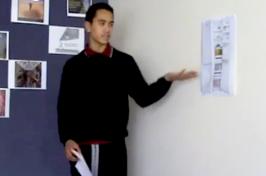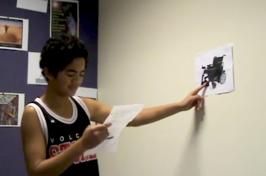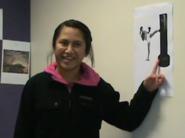Deepening understanding in the nature of technology
Teaching inquiry
How can I use speeches to develop my students’ understanding of technology?
Introduction
Following the success of her earlier Tēnei au introductions project, Clare Ravenscroft of Tai Wānanga Ruakura decided to make year 9 speeches an opportunity for cross-curricular learning too.
She found that through their work on the speeches, her year 9 students:
- were able to research and speak about a topic that was relevant to their lives
- identified and practised relevant language features for speeches
- grew their understanding of characteristics of technology and characteristics of technological outcomes.
Background
At Tai Wānanga, public speaking is regarded as an important skill. Every morning, the school day starts with a karakia and a waiata. Two students lead this part of the programme and then introduce themselves with their pepeha. Every student takes a turn at this.
This term, the students are also required to tell the school about their career aspirations. This gives them the opportunity to gain confidence in public speaking, and we are already seeing this happen. Principal Toby Westrupp models good public speaking, and often reminds the students that they must be proud of who they are, and always look at the person they are speaking to.
Clare Ravenscroft
Year 9 speeches

Clare’s idea was to have the students speak on the topic “A technological outcome that has had an impact on me or a member of my whānau”. Each student would deliver their speech to the other members of their small group.
In terms of technology, the aim was to design and develop a speech that could have a positive impact on another person. The learning outcomes of this would be understanding of the levels 1–2 component and the level 2 component.
Defining a technological outcome
Clare began by discussing with the students the distinction between technological and non-technological outcomes.
One student, thinking of her father’s grafted fruit tree, asked whether things in nature could be technological outcomes. This on to genetically modified foods. Even with their limited understanding, the students were quite clear that genetic modifications and the grafted tree were technological outcomes because they were human intervention for a purpose.
Clare Ravenscroft
Exploring vocabulary and concepts
To build their vocabulary and conceptual understandings, Clare brought in some old telephones. The students discussed their physical and functional attributes and how these had changed over time. The students had never seen a dial telephone before and enjoyed playing with it.
Planning and research

To complete the speeches in the five weeks allocated, it was important that the students be given a tight framework. The research involved was potentially enormous for a technological outcome that had been around for some time. It was agreed that five interesting facts about how the technological outcome had changed over time would be sufficient.
The "locate, select, organise" aspects of research were not strong in the Tēnei au project. I wanted to work on this with the students. I encouraged them to try and find two resources outside the internet. For example, they could interview a whānau member. I wanted to extend their ideas of where to look for and locate information. We all made a small origami-type book of A3 paper as a place to keep track of what we were doing at each stage of the research process.
Clare Ravenscroft
Writing the speeches
As they set about developing their speeches, the students discussed their selected technological outcome individually with Clare. This gave her an opportunity to clarify their understanding. As they completed the first drafts of their speeches, Clare reviewed these and provided feedback.
The class discussed the physical aspects of speaking (such as body language) and the use of visual aids (they were encouraged to choose and use just one aid). They also discussed the use of rhetorical language features. They particularly discussed repetition and figurative language, for example, metaphor and simile. Clare asked the students to try and use a range of language and presentation techniques.
Rather than simply identifying metaphors and similes in poems, it seemed a good idea to try using them in their speeches.
Clare Ravenscroft
Outcomes
It is often difficult to get students to give a speech, but in this case everyone did. Part of the reason, says Clare, is that the topic gave them the opportunity to choose and talk about something that was relevant to their lives.
Clare based her assessment of the students’ understanding on the evidence in their speeches, and the conversations she’d had with them as they researched and prepared their material. Seventy-five percent were at level 2 for characteristics of technological outcomes and the remaining twenty-five percent were at level 1.
I was happier with the students’ technology understandings than with their presentations. They found it a challenge to present on a topic that involved knowledge that was new to them.
Clare Ravenscroft
For characteristics of technology, Clare encouraged her students to think in terms of the three indicators below:
- Describe how particular technological outcomes have changed over time and identify if this resulted in changing how people do things.
- Describe examples to illustrate when technology has had a positive impact on society and/or the environment.
- Describe examples to illustrate when technology has had a negative impact on society and/or the environment.
Most students revealed some understanding of the first two indicators in their speeches. As they listened to each other’s speeches, they learnt more. Few commented on the negative impacts of their technological outcome. Clare decided to create a follow-up tutorial on the negative impacts of technological outcomes to get them thinking about this.
Some students used metaphors and similes in their speeches (one said, “the electric oven is the queen of the kitchen”); some also made effective use of visual aids.
Examples of the students' speeches
What next?
Clare’s students are getting the hang of the idea that a unit can include learning from more than one learning area, but she is still trying to work out how to make the basis of assessment transparent at the outset of cross-curricular projects.
I’m thinking of giving the students an outline at the beginning of the year (possibly using the progression diagrams, though these will need to be unpacked for the students) and then using this as the basis for a running record of progress.
Clare Ravenscroft
To overcome the problem of students reading their speeches, Clare plans to trial the use of a lectern next time, and to have the students make presentations instead of speeches.
Matariki has provided the impetus for the next project. Each student selects an area of life that interests them, for example, growing, fishing, food, and astronomy. The projects will be completed at different times. The previous year, all projects had to be completed at the same time, which created problems. Projects include rongoā Māori (traditional medicine), a home vegetable garden, a book, and fishing, hunting, and snares.

